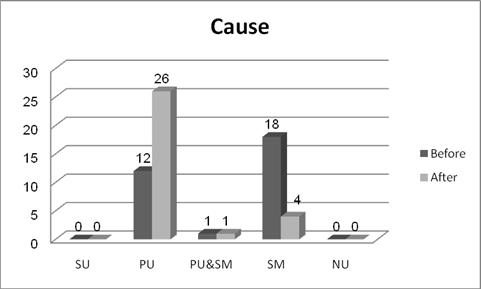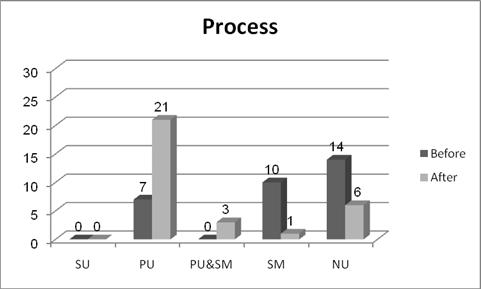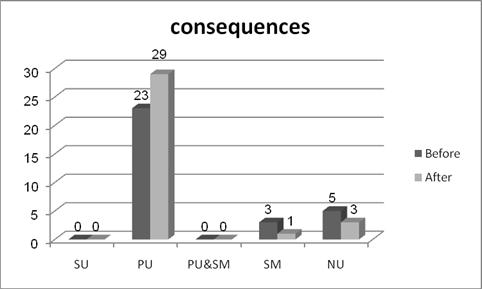Asia-Pacific Forum
on Science Learning and Teaching, Volume 11, Issue 1, Article 4
(Jun., 2010) |
The results are presented in three sections: first, the students’ perception of the keywords about global warming; second, the conceptual understanding of global warming; and third, the engagement against global warming.
1. Perception of global warming
Student’s perception of nine keywords related to the global warming issue before and after workshop the are presented in frequencies in Table 1.
Table 1: Student’s perception of the keywords related to global warming issue before and after the workshop (n = 31)
Keywords
Number of students (before/after) Never heard Heard Scientific based Non-scientific based 1. Greenhouse effect
2. Climate change
3. Coral reef bleaching
4. Kyoto Protocol
5. Biodiesel
6. Gasohol E20
7. Diesel B5
8. Non-renewable energy
9. Renewable Energy0/0
2/2
28/0
18/2
3/3
10/7
19/16
6/1
3/37/21
0/10
2/14
1/16
9/17
7/13
2/5
11/18
2/1224/10
29/19
1/17
12/13
19/11
14/11
10/10
6/5
26/16Before the drama workshop, it showed that some of the keywords related to global warming were more widely known among students than the others. These are greenhouse effect, climate change, biodiesel, non-renewable resource, and renewable resource. Coral reef bleaching and Kyoto Protocols are much less known by the students. Most of those who had heard the “popular” terms, however, gave non-scientific explanations. For example, on the concept of climate change, the students thought that the climate change was an unexpected fluctuation in weather conditions within a short period of time in a certain region. Scientifically, climate change is any long-term change in the statistics of weather over durations ranging from decades to millions of years. It can be manifest in changes to averages, extremes and may occur in a specific region or for the Earth as a whole (De Freitas, 2002). On the concept of alternative energy, another example, the students could not identify the raw materials and the production process. Some of the students were confused between those of biodiesel and gasohol. After the drama workshop, however, it found that, the number of students holding a scientific based view was found to have increased, while those with non-scientific views dropped. The workshop could make the previously unknown/unfamiliar keywords; coral reef bleaching and Tokyo Protocol better known and aligned with scientific conception.
2. Conceptual understanding of global warming
2.1 Cause of global warming
In the pre-workshop, the majority of students held specific misconceptions (18 students: see Figure 5). Two of the most common ones are presented as follows. First, they thought that carbon monoxide, particulate matter such as dust and diesel exhaust, and extra sunlight from the sun were greenhouse gases. Greenhouse gases, scientifically, consist of varying amounts of water vapor and cloud (97%) with the remainder being gases like CO2, CH4, Ozone, and N20 (De Freitas, 2002). Second, the students thought that all sources of CO2 emission were involved with human activities such as burning fossil fuels and deforestation. CO2 was viewed as a pollutant or toxic gas in the air. In fact, this gas, as well as other greenhouse gases, also occurs naturally in the atmosphere and is essential to life on earth in the process of photosynthesis and respiration. Greenhouse gases are responsible for keeping the Earth warm; without them, the Earth would be frozen and lifeless. Although there were no students having sound understanding before and after the drama workshop, the number of students having partial understanding increased from 12 to 26. This group of students thought that there were only a few types of greenhouse gases. Greenhouse gases such as methane were hardly mentioned and few students referred to nitrous oxide, tropospheric ozone and water vapor. The number of students having specific misconceptions decreased from 18 to 4.
Figure 5: Frequencies of students with different levels of conceptual understanding of the causes of global warming before and after the drama workshop
2.2 Process of global warming
In the pre-workshop, the majority of students had a specific misconception and no understanding about the process of global warming, greenhouse effect (24 of 31: see Figure 6). There were two common specific misconceptions held among this group of students. First, they thought that global warming was a result of ozone depletion. The loss of the ozone layer and climate change are strongly connected; the hole in the ozone layer causes global warming. The ozone hole exposes the Earth to higher UV radiation levels from the sun. The following dialogue was taken from the conversation between the researcher and a group of students about the process of global warming just before doing a lab exercise on the first day.
R [Researcher]: How is the earth getting warmer?
S [Student] 1: Ozone layer acts like a blanket protecting the earth from the solar heat. When it is destroyed, the sunlight can get through and hit the ground more. It makes our earth warmer.
R: How is the ozone layer depleted?
S: Smoke from traffics, CFCs leaked from used air conditioners, hair spray, refrigerator and the like. These chemicals break down the molecules of ozone.
The second common alternative conception was that the students could not distinguish incoming, solar, short wave radiation from outgoing, long-wave, trapped rays. Most students thought it was solar rays that warmed the earth. The absorption of gases being dependent on wavelength was largely unknown by the majority of students. This indicates that students have difficulties viewing the Earth as a radiating object. Although, after the workshop, there were still no students having sound understanding (SU), the growth of scientific understanding was noticed. That is, the numbers of students having Partial Understanding (PU) increased from 7 to 21, while the numbers of Specific Misconception (SM) and No Understanding (NO) had decreased from 10 to 1, and 14 to 6, respectively. The conceptual change is evident in the following dialogue while they were doing the experiment.
R: What have you got?
S1: The temperature in the bottle A (the one with extra carbon dioxide) increases constantly.
R: What about the other?
S1: It also goes up but not as high as the bottle A?
R: How would you explain such difference?
S1: The bottle A has more CO2 than bottle B. This gas, I think, traps the heat and accumulates it inside the bottle.
After doing the experiment, the class made a link between the experiment and the real phenomena; how the experiment simulates the mechanism of global warming. From the notes in their journals, many students changed their alternative conception to a scientific conception. This alternative conception was highlighted in the script. The alternative conception and scientific conception are communicated through the drama script as follows:
Thai PM: Nowadays, there are so many countries heavily depending upon industrial sector. This sector emits greenhouse gases such as CO2, methane, water vapor, CFCs.
Chinese Premiere: CFCs, in particular, you know? It destroys our ozone layer. Without the ozone layer, almost all sunlight can hit the earth. The earth as the result is warmer. Now people can get skin cancer easier than ever.
Korean PM: No…No…You misunderstood. Listen! Listen! (Looks at other PMs and the audience). It doesn’t work that way. The increase in the rate of skin cancer is not the consequence of global warming.
President of the World: (looks so confused) What exactly is the cause of global warming? (Look at his first secretary) Judith, call Prof. Brendon on. He is the expert.
Figure 6: Frequencies of students with different levels of conceptual understanding of the process of global warming before and after the drama workshop
2.3 Consequences of Global warming
At the beginning, there were no students having Sound Understanding (SU). The majority of students had partial understanding of the consequences of global warming. However, after the workshop, the number of students holding Partial Understanding increased from 23 to 29 (See Figure 7). The students having Specific Misconception and No Understanding decreased. The partial understanding responses focused on large regional or global climatic change, unexpected natural disasters and human health issues such as drought, flooding, heat waves, and the declining perennial polar ice cap in the Arctic. These students did not explain how these physical changes would threaten the economy, society, and ecosystem. Few students were concerned about a substantial reduction in crop yields that could lead socio-economic crises. None of them saw the ecological effect of global warming. They did not see how increasing global temperature affected physical and biological factors in an ecosystem and how this would trigger ecological change such as changes in range and seasonal behavior in certain species of plants and animals, reduction in ecological productivity and survival rate. Specific misconception was also found. The students thought global warming would result in an increase in the prevalence of skin cancer. This could be the result of the misconception of ozone depletion as the mechanism of global warming.
Figure 7: Frequencies of students with different levels of conceptual understanding of the consequences of global warming before and after the drama workshop
However, the students presented various consequences of global warming in their drama as shown the in following script.
At the opening scene:
People who have been suffered from global warming come on stage.
[Three sisters are swimming out]
First sister: I am so tired. I have been swimming for so long. I am sinking into the sea. Help! Help!
Second sister: You know [asks the audience]? In the past, we used to have ten thousand Rai [3954 acres]. Our land has been inundated by sea level rise. Now only 50 meter square is left over. How sad!!
Third sister: Sisters, shut up and listen! Look at that the ferry. It is approaching.
[Kai and her mother on the ferry saw the sinking girls and asked the crew to help. The girls, hence, were pulled up. Kai is back to her ice cream. Kai talked to her mother sadly.]
Kai: Mom, look at my ice cream. It is melting so quickly. It is unusual.
Mom: Don’t be sad. Let’s get the new one. We have plenty.
Kai: No, I don’t want it anymore.
[Suddenly, two celebrities come out and start complaining to the audience]
Hom Yai: Why today is so hot? I feel like being in a hot tub. Look at my skin, Hom Dang. Getting dark and shrinking. My SPF 999 sun block could not protect my tender skin [Screaming].
Hom Dang: What a pity! The weather is unpredictable. It is supposed to be cold now [Mid-December]. Last weekend I visited Mt. Everest, but there was no snow. Incredible!
Everyone on stage: These must be the consequences of global warming!! We do need help. Mr. President of the World, where are you? [calling on and searching for]
3. Engagement against global warming
Before the drama workshop, the students could suggest a number of ways to cut down the level of carbon dioxide in the atmosphere (Table 2) such as planting more trees, recycling paper, saving electricity, riding a bicycle etc. However, most students could not explain how these environmental actions would solve global warming. Notably, most of their CO2 reducing strategies were undertaken at the level of the individual. A very small number of students discussed the role of government, the private sector, state agencies, local authorities and community members in solving global warming. A few mentioned public hearings, conversations, and forums on global warming issues or the like in order to establish programs and policies to reduce in the concentrations of greenhouse gases. In fact, environmental solutions would be possible only if the commitment and cooperation from all stakeholders is established.
Table 2: on students’ responses on the engagement against global warming
Things to do to stop global warming
Before
After
Individual/ isolated view
Plant a tree
16
16
Protect and conserve forest
16
16
Use a cloth bag
16
8
Choose energy efficient appliances
15
14
Reduce waste
14
15
Use recycled paper.
14
15
Turn off electric appliances when not in use
13
15
Reuse shopping bag
12
14
Car sharing
10
15
Walking, biking instead of taking a bus
8
12
Buy refills
7
10
Replace a regular incandescent light bulb with a compact fluorescent light bulb
7
9
Choose products that come with little packaging
6
4
Create an energy efficient home.
5
14
Communal / Integrated view
Get informed and educate others.
2
15
support green power
2
9
Join the virtual march/ run environmental campaign
-
9
Think about the impact of your investments
-
5
Tell the government to act
-
16
International cooperation
-
15
Others (one student per category)
4
4
By the end of the workshop, there was an increase in the number of students having an integrated way of tackling global warming for example, supporting green power, joining the virtual march and running environmental campaign, urging for the laws against global warming, calling for internal cooperation etc. Wannisa, in a written response, wrote, "We must ask our government to enact new laws that cap carbon emissions and require polluters pay for the global warming gases that they produce. This would have greater impact in a long run". Wannisa thought the solution of global warming would be successful once political leaders stepped in, the laws enacted and enforced. Jettana, a Grade 8 boy, another example, suggested using social network to tackle global warming. In his journal, he wrote, "why not we use technology that we all are good at to stop global warming. We access Facebook every day. I will create one and invite friends to join in so we can share and learn tips to reduce the emission of greenhouse gas". From his text, he showed concern on global warming and contributed significant time and effort to the business. He fully invested in the mission and led other in carrying out the environmental action. The students' integrated view was also reflected in the following drama script.
President of the World: I agree with what you have just said but the situation on my planet is much worse than yours. We are getting to the dead end. Do you have any suggestions for what we can do to save our planet?
Green Head: I admire you. Once people are concerned, change will definitely occur. It is not too late, Mr. President. You should tell your people to plant more trees, use public transportation rather a private car, implement green technology, alternative energy, and use natural resources in a sustainable way. All these things would cut off the emission of greenhouse gas. Sincere and serious action is the key to success.
Copyright (C) 2010 HKIEd APFSLT. Volume 11, Issue 1, Article 4 (Jun., 2010). All Rights Reserved.



